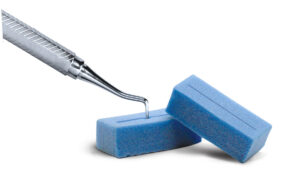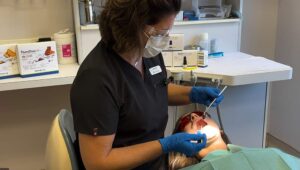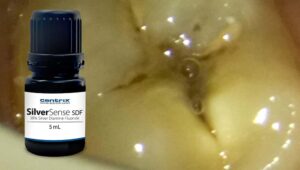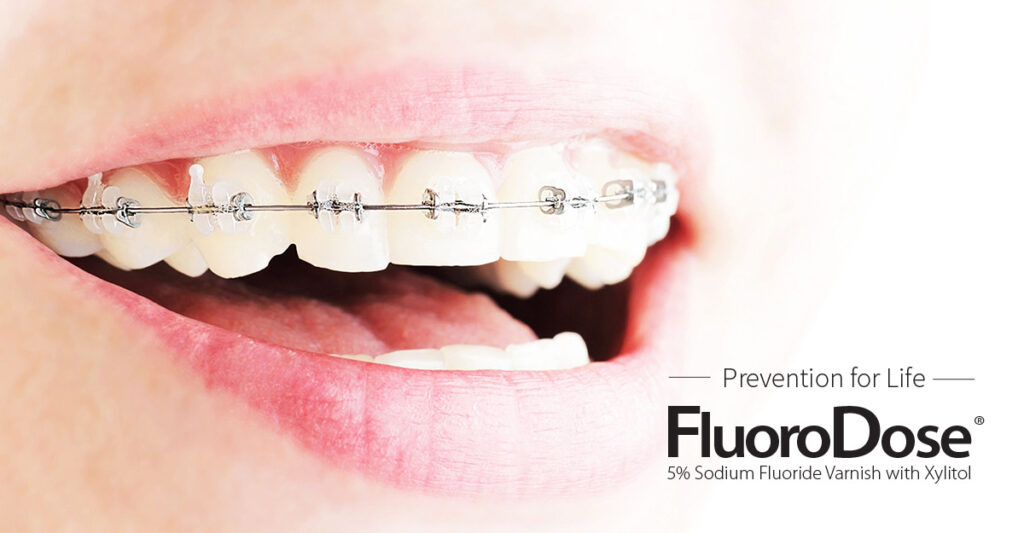Have you seen polka-dotted teeth in your office?
White spots (otherwise known as Caries Lesions or Hypocalcification) on teeth can result from a variety of causes. Most white spots are formed during the development of the tooth while in the jaw. If the tooth is disturbed, or a change in the body causes the enamel formation to be atypical, white spots will occur however they are usually a sign of enamel breakdown and decalcification. Caries lesions are also common during orthodontic treatment and usually form around the bracket interface near the gingival margin. If plaque and bacteria builds up, such as streptococci and lactobacilli, they create an acidic environment around braces and over time enamel breakdown can occur resulting in white spots. These white spots can be permanent on the teeth and can lead to tooth decay. Studies show that over 60.9 % of patients with braces develop white spots.1 The ADA states “active orthodontic treatment” is a risk factor for cavities due to plaque removal being difficult with orthodontic appliances2.
Steps to reduce white spots with your patients
- Regular visits to the general dentist – Regular cleaning and patient education with an emphasis on the importance of oral hygiene is key! AAO provides patient educational materials you can use with your patients.
- Fluoride varnish – When applied properly, fluoride varnish has a proven track record in white spot reduction. In a study by Cochrane Database of Systematic Reviews, “… the application of fluoride varnish was an effective measure in reducing white spots lesions. The report conclusion states, “This review found some moderate evidence that fluoride varnish applied every six weeks at the time of orthodontic review during treatment is effective.”3
- Fluoride mouthwash – Daily fluoride rinse is recommended however patient compliance may be low.
- Sealants – For patients that show poor oral hygiene, sealant can be added before and after bracket bonding.
Conclusion
Even with excellent oral hygiene, having braces puts your patients at a greater risk for white spots and dental decay. A proactive oral prevention program is highly recommended. The provider as well as the patients’ need to take measures to reduce enamel demineralization while the patient is undergoing orthodontic treatment.
- Enaia M, Bock N. Ruf S. White-spot lesions during multibracket appliance treatment: A challenge for clinical excellence. Am J Orthod Dentofacial Orthop 2011;140(1)17-24
- www.ada.org
- Benson PE, Parkin N, Dyer F, Millett DT, Furness S, Germain P. Fluorides for the prevention of early tooth decay (demineralised white lesions) during fixed brace treatment Cochrane Database of systematic reviews 2013, 12
Boost Your Expertise with Our Lunch & Learn Programs!
Join our engaging Lunch & Learn sessions and take your dental skills to the next level. Enjoy a meal while learning from experts about evidence-based solutions, prevention, restorative procedures, and more. Enhance your practice and patient outcomes with our comprehensive courses.
Share
You Might Also Like...

Composite Sculpting is a Breeze with LubeCube!
Composite sculpting doesn’t need to be a pain! Learn more about why LubeCube is a must-have accessory for restorative dentists.

The Value of Prevention: How Simple Preventive Procedures Transform Your Practice
While most of us agree that preventive care is important, the truth of the matter is, prevention gets placed on the backburner of most dentists’ minds.

Silver Diamine Fluoride is Not Just for Kids!
Dentists working with elderly patients and patients with disabilities also saw the value of the product for their patients and swiftly added SDF into their toolkits.



